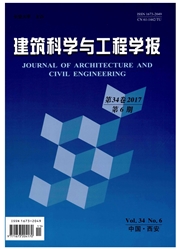

 中文摘要:
中文摘要:
针对上海地铁运行引起地面振动的预测问题,应用振源模型计算不同车速对轨道基础的激振力,应用传播模型计算不同激振力输入下的地面振动加速度,建立了“地铁-隧道-土层”系统动力有限元模型。通过对比数值模拟结果与实测结果,分析了不同因素对地铁引起地面振动的影响规律。结果表明:随着地铁车速增加,振源激振力和地面振动加速度的幅值均明显增大;地面上距地铁中心线30m范围内各点振动加速度峰值随距地铁中心线距离由近及远呈幂函数形式衰减;地面振动加速度频率主要为低频振动,随着距地铁中心线距离的增大,高频衰减相对于低频更为明显;建议上海地区建筑尽量在地铁中心线20m范围外进行规划,或采取降低设计车速、减轻车辆荷载、优化隔振措施等方法,减少地铁运行引起地面振动对地面建筑及居民生活的影响。
 英文摘要:
英文摘要:
On the purpose of studying on ground vibration induced by subway, the vibration source model was applied to calculate the exciting force caused by different train speeds, and the propagation model was applied to calculate the ground vibration caused by different exciting forces, then the dynamic finite element model of "metro-tunnel-soil" system was established. By contrasting the numerical results and measured results, the influence law of ground vibration affected by different factors was analyzed. The results show that the exciting force and the ground vibration acceleration increase obviously with the increase of train speed; the ground vibration acceleration peak value decreases significantly as the distance to tunnel increases, and their relationships with the distance can be represented by power function within 30 m range from center line of subway; the ground vibration acceleration frequency is mainly concentrated in low frequency, and the high-frequency actuation is more obvious than low frequency actuation; it is recommended to take construction gauge outside 20 m of center line of subway, or reduce the design speed and the vehicle load, or optimize vibration isolation measure, to reduce environmental impact of local residents in Shanghai area.
 同期刊论文项目
同期刊论文项目
 同项目期刊论文
同项目期刊论文
 期刊信息
期刊信息
